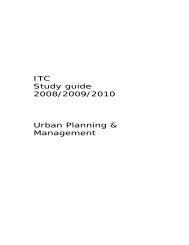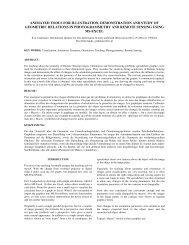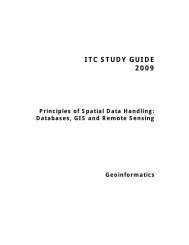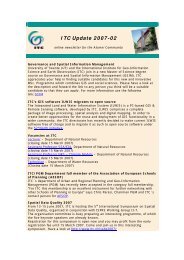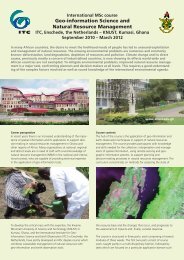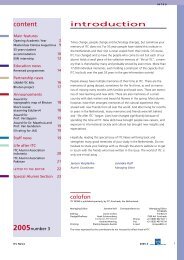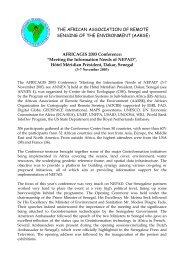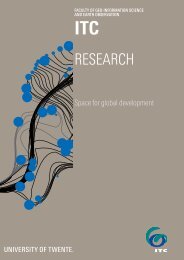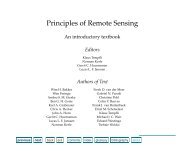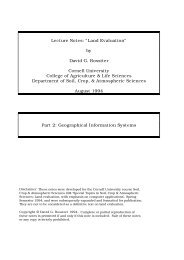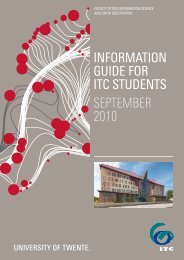Sensitivity Analysis of Soil Site Response Modelling in Seismic ... - ITC
Sensitivity Analysis of Soil Site Response Modelling in Seismic ... - ITC
Sensitivity Analysis of Soil Site Response Modelling in Seismic ... - ITC
Create successful ePaper yourself
Turn your PDF publications into a flip-book with our unique Google optimized e-Paper software.
and create more severe strong ground motions at the surface. Many earthquake prone cities are settled<br />
over very susceptible areas with young deposits such as Mexico City (Seed, Romo et al. 1987), Loma<br />
Prieta (Rodriguez-Marek and Bray 1999) and Kathmandu/Nepal. Hav<strong>in</strong>g a high potential for earthquakes<br />
and a susceptible local site environment, the situation <strong>in</strong> Kathmandu might turn a hazard <strong>in</strong>to a<br />
disaster <strong>in</strong> the future.<br />
In microzon<strong>in</strong>g the seismic hazard is assessed by means <strong>of</strong> expected response <strong>of</strong> the seismic waves for<br />
a given (scenario) earthquake for a specific area. S<strong>in</strong>ce the local soil site has significant effects on the<br />
seismic waves, “Ground <strong>Response</strong>” is one <strong>of</strong> the most important sections <strong>in</strong> microzon<strong>in</strong>g. Additionally,<br />
the subsurface and surface conditions <strong>in</strong> Kathmandu valley also are favourable for the occurrence<br />
<strong>of</strong> secondary hazards such as landslides, liquefaction, and fires.<br />
Ground response studies could be handled <strong>in</strong> different dimensions: one, two or three-dimensional.<br />
One-dimensional ground response analyses are based on the assumption that the ground surface and<br />
all material boundaries below the ground surface are horizontal and extend <strong>in</strong>f<strong>in</strong>itely <strong>in</strong> all lateral directions<br />
(Kramer 1996). The methods <strong>of</strong> one-dimensional ground response analysis are useful for level<br />
or gently slop<strong>in</strong>g sites with parallel material boundaries. The subsurface geology <strong>of</strong> Kathmandu Valley<br />
is also assumed to be suitable for one-dimensional ground response analysis, as Kathmandu valley is<br />
underla<strong>in</strong> by a thick deposit <strong>of</strong> alluvial and lacustr<strong>in</strong>e deposits. In addition, the assumption that the<br />
valley or another topographical feature could be one-dimensional is a major simplification.<br />
For one-dimensional calculations <strong>of</strong> the ground response, SHAKE s<strong>of</strong>tware is used widely s<strong>in</strong>ce<br />
1971(Ordonez 2002). Us<strong>in</strong>g SHAKE, the research problem then tends to focus on sensitivity analysis<br />
<strong>of</strong> the seismic response modell<strong>in</strong>g for Kathmandu city, which will try to def<strong>in</strong>e and simplify the <strong>in</strong>formation<br />
needed and evaluate it with<strong>in</strong> the concept <strong>of</strong> microzonation analysis. The ma<strong>in</strong> reason to<br />
focus on sensitivity analysis is to try to get more <strong>in</strong>formation for the valley, where there is lack<strong>in</strong>g <strong>in</strong><br />
data.<br />
1.2. Problem Statement<br />
In general terms, a seismic response analysis needs detailed geotechnical data, geology <strong>in</strong>formation,<br />
thickness <strong>of</strong> the subsurface geology pr<strong>of</strong>iles and a specific earthquake accelerogram file. More details<br />
on the required data will be expla<strong>in</strong>ed <strong>in</strong> the com<strong>in</strong>g section.<br />
Many countries, which are vulnerable to earthquakes, are lack<strong>in</strong>g <strong>in</strong> data for seismic response studies.<br />
Estimat<strong>in</strong>g the soil site response for strong ground motion is costly. In order to quantify the expected<br />
ground motion, we have to determ<strong>in</strong>e the manner <strong>in</strong> which the seismic signal is propagat<strong>in</strong>g through<br />
the surface. Propagation is particularly affected by the local geology and the geotechnical ground conditions.<br />
Borehole data, geotechnical, geological and geophysical parameters should be determ<strong>in</strong>ed.<br />
Such an <strong>in</strong>vestigation is not always easy to obta<strong>in</strong> hence you will need people with sufficient knowledge,<br />
tools, and laboratories which is not always the case for many develop<strong>in</strong>g countries.<br />
In Kathmandu the available data is not sufficient .To deal with this gap, numerical analysis could be<br />
used additionally to the exist<strong>in</strong>g data. For seismic response analysis the readily available data was used<br />
and then sensitivity analysis was applied. The aim <strong>of</strong> sensitivity analysis is to estimate the rate <strong>of</strong><br />
change <strong>in</strong> the output <strong>of</strong> a model with respect to changes <strong>in</strong> model <strong>in</strong>puts (Isukapalli 1999). A priority<br />
order for the <strong>in</strong>put parameters will be produced from the sensitivity assessment.<br />
4<br />
<strong>Sensitivity</strong> <strong>Analysis</strong> Of <strong>Soil</strong> <strong>Site</strong> <strong>Response</strong> <strong>Modell<strong>in</strong>g</strong> In <strong>Seismic</strong> Microzonation For Lalitpur, Nepal



